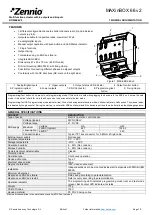MC68332
SYSTEM INTEGRATION MODULE
USER’S MANUAL
4-55
to %00 (CPU space), interrupt priority (ADDR[3:1]) is compared to IPL value. If the val-
ues are the same, and other option register constraints are satisfied, a chip select sig-
nal is asserted. This field only affects the response of chip selects and does not affect
interrupt recognition by the CPU. Encoding %000 causes a chip-select signal to be as-
serted regardless of interrupt acknowledge cycle priority, provided all other constraints
are met.
The
AVEC
bit selects one of two methods of acquiring an interrupt vector during an
external interrupt acknowledge cycle. The internal autovector signal is generated only
in response to interrupt requests from the SIM IRQ pins.
4.8.1.4 PORTC Data Register
The PORTC data register latches data for PORTC pins programmed as discrete out-
puts. When a pin is assigned as a discrete output, the value in this register appears at
the output. PC[6:0] correspond to CS[9:3]. Bit 7 is not used. Writing to this bit has no
effect, and it always reads zero.
4.8.2 Chip-Select Operation
When the MCU makes an access, enabled chip-select circuits compare the following
items:
1. Function codes to SPACE fields, and to the IPL field if the SPACE field encod-
ing is not for CPU32 space.
2. Appropriate ADDR bits to base address fields.
3. Read/write status to R/W fields.
4. ADDR0 and/or SIZ bits to the BYTE field (16-bit ports only).
5. Priority of the interrupt being acknowledged (ADDR[3:1]) to IPL fields (when the
access is an interrupt acknowledge cycle).
When a match occurs, the chip-select signal is asserted. Assertion occurs at the same
time as AS or DS assertion in asynchronous mode. Assertion is synchronized with
ECLK in synchronous mode. In asynchronous mode, the value of the DSACK field de-
termines whether DSACK is generated internally.DSACK also determines the number
of wait states inserted before internal DSACK assertion.
The speed of an external device determines whether internal wait states are needed.
Normally, wait states are inserted into the bus cycle during S3 until a peripheral as-
serts DSACK. If a peripheral does not generate DSACK, internal DSACK generation
must be selected and a predetermined number of wait states can be programmed into
the chip-select option register.
Refer to the
SIM Reference Manual (SIMRM/AD) for further information.
4.8.3 Using Chip-Select Signals for Interrupt Acknowledge
Ordinary I/O bus cycles use supervisor space access, but interrupt acknowledge bus
cycles use CPU space access. Refer to
for more information. There are no differences in flow for chip selects in each type of
space, but base and option registers must be properly programmed for each type of
external bus cycle.
F
re
e
sc
a
le
S
e
m
ic
o
n
d
u
c
to
r,
I
Freescale Semiconductor, Inc.
For More Information On This Product,
Go to: www.freescale.com
n
c
.
..


















